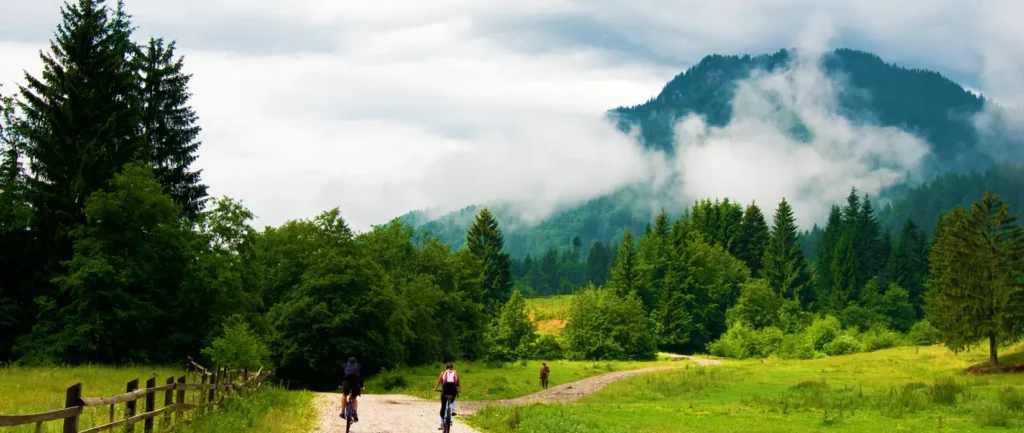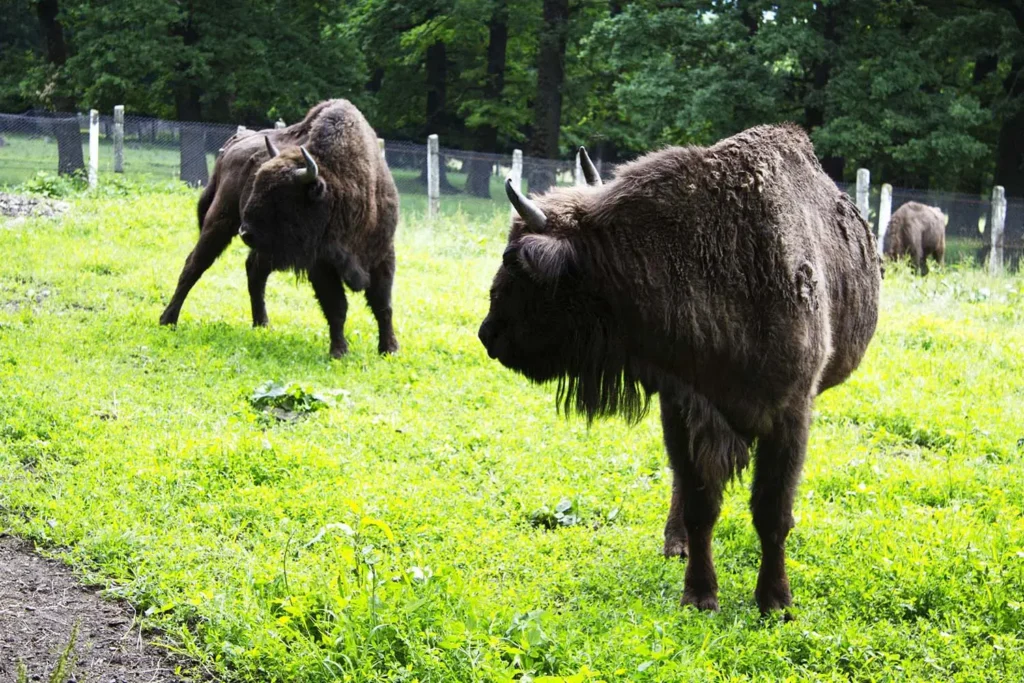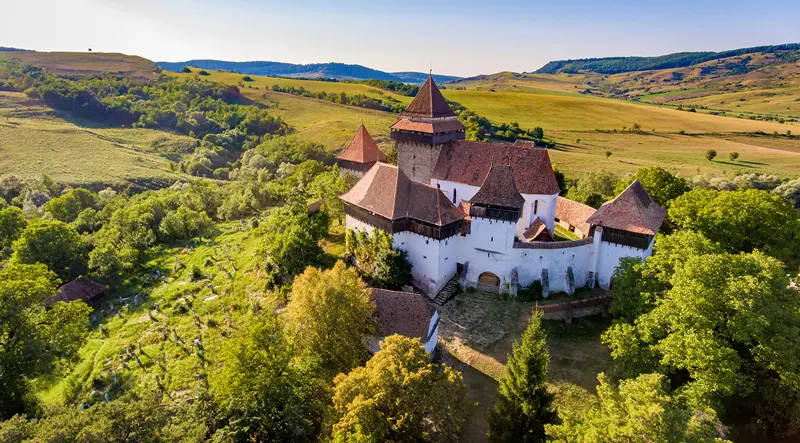Chapters
There are journeys that show you places, and there are journeys that change the way you feel about time itself. A countryside holiday in Romanian villages belongs to the second kind. Here, the rhythm of life slows to match the beating of a church bell, the clink of cowbells on the hills, or the steady hum of a loom in a villager’s home.
To understand Romania, you must leave behind the highways and step into its villages. This is where the country’s soul has been carefully preserved; it is a world of living traditions, homemade flavors, and celebrations that seem untouched by the modern rush.
What’s it really like to stay in a Transylvanian village?
Honestly, it feels like time slows down. You hear the church bell, see horse carts on the road, and smell fresh bread baking — it’s simple, calm, and a little magical.
The first encounter with Romanian villages often happens in Transylvania. The road winds through rolling hills, and suddenly a cluster of brightly painted houses appears, guarded by a tall fortified church. Villages like Viscri or Biertan still carry the mark of their Saxon founders: neat rows of houses, thick wooden gates hiding courtyards full of flowers, and cobbled lanes where life moves at walking pace.

Arrive in Viscri in the early morning and you’ll find women bringing bread out of clay ovens, the smell of fresh loaves mixing with the smoke of wood fires. Old men ride past in horse carts stacked high with hay, waving cheerfully at strangers. The fortified church stands silently above it all, its thick walls a reminder that this was once a place of defense — and now a symbol of resilience.
Rimetea is a place where architecture and landscape merge into harmony. Famous for its whitewashed houses with green shutters, the village has preserved this consistent aesthetic for centuries, giving it an almost timeless character. Walking through its narrow lanes feels like stepping into a well-kept secret, with every home reflecting a shared sense of identity. What makes Rimetea even more special is its geographical setting — cradled at the base of the Piatra Secuiului cliffs. Here, travelers witness a rare phenomenon: the double sunrise. As the sun first climbs over the horizon, it vanishes behind the cliff, only to rise again minutes later.

In Cincșor, a school has been transformed into a guesthouse where books line the walls and meals are prepared with produce from nearby gardens. Guests gather around long wooden tables for dinners of bean soup, roast meats, and homemade jams. Evenings end with local wine and stories about the village’s past — tales of Saxon settlers, Romanian farmers, and the intertwining of cultures that shaped this land.
But the true spirit of Transylvania lies not just in architecture or food, but in its connection to the land. In mountain villages like Șirnea, shepherds welcome visitors to their summer huts. They slice wheels of fresh cheese, still warm from being pressed, and tell stories of transhumance — the ancient tradition of moving sheep between valleys and mountains with the seasons. Watching the sun sink behind the Carpathians, you begin to understand why life here never needed to change.
High in the Apuseni Mountains lies Runcuri, a village where houses are built not just with wood and stone, but with hay itself. The thick thatched roofs cover homes almost entirely, making them blend seamlessly into the meadows around them. At first glance, the houses seem like oversized haystacks scattered across the hills, giving the landscape a surreal and harmonious look. This building technique, born out of necessity and local resources, has given Runcuri its unmistakable character. Life here is simple, shaped by the seasons and the land. The village is also set in a spectacular natural setting, with rolling pastures and limestone plateaus that attract hikers and those seeking rural tranquility.
 Photo source: bandarosie.ro
Photo source: bandarosie.ro
Do people in Maramureș still live by the old ways?
They do. On Sundays, you’ll see whole families walking to church in traditional clothes, and in summer they’re out in the fields making hay the old way. It’s everyday life, not a show.
This northern region is often called an open-air museum, but it is no museum at all — it is life as it has always been lived. Wooden gates carved with spirals, suns, and wheat motifs guard homesteads where families still work the land with scythes and oxen.

Breb has earned its reputation as the “soul of Maramureș.” It is one of the few villages where everyday life still unfolds much as it did centuries ago. Here, villagers guide horse-drawn carts through unpaved lanes, women weave on wooden looms, and families gather in courtyards framed by towering haystacks. The village is also home to some of the region’s finest wooden houses, with steep roofs and carved gates that are as much symbols of identity as they are of craftsmanship. Breb has drawn international attention too: King Charles III (as Prince Charles) bought and restored houses here, supporting efforts to preserve local traditions. Visitors who come to Breb don’t just pass through — they often stay in small guesthouses run by locals, sharing meals cooked with recipes unchanged for generations.
On a Sunday morning in Romanian villages like Botiza or Ieud, the streets fill with villagers dressed in traditional costumes. Women wear embroidered blouses and pleated skirts, their heads wrapped in scarves, while men wear white shirts with wide belts. They walk together to the wooden church, its tall spire piercing the sky, the air alive with the sound of bells. For visitors, it is like stepping into another century — yet for locals, it is simply life.
Hospitality in Maramureș is legendary. Guests are welcomed with plum brandy (pălincă) and plates of fresh bread, cheese, and smoked ham. Sit by the fire in a wooden house, and stories flow as freely as the drink. Villagers share tales of weddings that last three days, of haymaking traditions, of dances that bring the whole community together.

In summer, the fields are dotted with haystacks — tall, sculptural, almost artistic. Visitors are invited to help with the harvest, learning how to swing the scythe or stack hay under the hot sun. It is hard work, but laughter and singing accompany the effort, and at the end of the day, a communal feast awaits.
Why do travelers fall in love with Bucovina’s villages?
Because they have something you won’t find anywhere else: painted monasteries covered in centuries-old frescoes. Add egg-painting workshops and the warmest hospitality, and you’ll see why people remember them.
In Bucovina, spirituality and rural life are intertwined. The villages here are famous for their painted monasteries — Voroneț, with its vivid blue frescoes; Moldovița, where entire walls narrate biblical stories; Sucevița, guarded by green hills. These are not monuments behind glass; they are living places of worship, and villagers still cross themselves as they pass.

Stay in a Bucovina village, and you’ll discover a culture of artistry. In homes and workshops, women practice the delicate art of egg painting — a tradition especially tied to Easter. Using beeswax and dyes, they create intricate patterns filled with symbolism: spirals of eternity, suns of life, crosses of faith. Visitors can sit with these artisans, learning the patience and meaning behind each design.
Unlike any other village in Romania, Ciocănești has turned its homes into living canvases. Each house is painted with motifs inspired by Bucovina’s traditional Easter eggs — spirals, crosses, stars, and floral patterns that carry deep symbolic meaning. The tradition began in the 1950s, when locals decided to celebrate their heritage by decorating not just eggs but also the very walls of their homes. Today, walking through Ciocănești is like entering an open-air museum where every street is alive with color and meaning. Beyond its houses, the village keeps traditions strong through annual festivals, from trout-based gastronomy events to celebrations of egg painting. Ciocănești shows how folk art can shape not just objects, but the very fabric of a community.
 Photo source: jurnalul.ro
Photo source: jurnalul.ro
Life in Bucovina is also marked by celebrations. At Christmas, masked carolers dance through the villages, their costumes blending pagan and Christian symbols — goats, horses, devils, angels. In summer, harvest festivals fill the air with fiddles and flutes, while tables groan under plates of sarmale (stuffed cabbage rolls), pies, and homemade cakes.
Meals are central to the Bucovina experience. A villager’s home is the best restaurant you will find: soup with sour cream, mămăligă (polenta) with cheese, and meats flavored with herbs from the garden. And always, there is time to sit, talk, and share — because here, food is not just nourishment but an expression of hospitality.
How do families live in the Danube Delta villages?
Life here is all about the water. People fish at dawn, cook what they catch, and get around by boat. In some villages you’ll even hear Russian spoken, because the Lipovan community has kept its traditions alive for generations.
Reached only by boat, the Romanian villages of the Danube Delta sit at the edge of Europe’s last great wilderness, where rivers weave into lagoons and reeds rise taller than a person.

Life here is inseparable from water. Houses are built on high ground, painted in shades of blue and white, with thatched roofs designed to withstand the damp climate. Fishermen set out at dawn in narrow wooden boats, casting their nets as pelicans rise in the morning mist. Villagers still smoke fish using methods passed down for generations, and meals are often centered around the catch of the day — carp, catfish, or the famous Delta sturgeon.
The Danube Delta is also a crossroads of cultures. In villages like Mila 23, founded by Lipovan Russians who fled religious persecution centuries ago, traditions are preserved in language, clothing, and cuisine. In Sfântu Gheorghe, where the river meets the Black Sea, Orthodox festivals blend with fishing rituals.
 Photo source: facebook.com/magicromania
Photo source: facebook.com/magicromania
Visitors who spend time in these communities discover a rhythm of life shaped by water, nature, and resilience. Evenings end with stories told under star-filled skies, the silence broken only by frogs and the splash of fish. To stay in a Danube Delta village is to witness how humans and nature can live in balance, side by side.
Why is Banat home to some of Romania’s most surprising ethnic villages?
Because here, centuries-old Czech and German communities have preserved their way of life, making Banat a land of rare cultural contrasts.
Eibenthal is a small mountain village in Mehedinți County, part of the Banat region, founded in the 1820s by Czech settlers. Along with five other nearby villages (Bigr, Gernik, Rovensko, Șumița, and Sfânta Elena), it forms what’s known as the Banat Czech enclave.
What makes Eibenthal unique is that, despite being in Romania, daily life still flows in Czech. The villagers have preserved their language, traditions, recipes, and even their Catholic faith for nearly two centuries. Weddings, harvest festivals, and church celebrations are marked by Czech folk costumes and songs, creating the feeling that you’ve stepped into Central Europe while standing in the Southern Carpathians.
 Photo source: facebook.com/eibenthal
Photo source: facebook.com/eibenthal
The village is surrounded by forests and hills, and isolation helped keep its culture intact. Farming, livestock, and forestry remain the main livelihoods. In recent years, Eibenthal has also become a destination for eco- and cultural tourism, drawing travelers who want to see this rare cultural survival story.
An annual highlight is the Banat Festival, a music and culture event organized with Czech support, which brings together artists from Romania and the Czech Republic. It celebrates the community’s dual identity — Romanian by geography, Czech by heritage.
Not far away, Charlottenburg tells a different story. Founded in the 18th century by Swabian settlers, it is the country’s only circular village, and one of very few in Europe. From above, its streets form three perfect concentric rings, with houses and gardens radiating outward from a central square. This unusual design was not only aesthetic but practical, intended to foster community cohesion and efficient land use. More than two centuries later, the layout remains intact, giving Charlottenburg the feel of a rural mandala. For visitors, it is a fascinating blend of history, architecture, and cultural heritage, showing how one small village can embody the ambitions and resilience of its founders. Charlottenburg’s uniqueness lies not only in its geometry but also in its ability to preserve a rare model of village planning in a world where such experiments rarely survived.
 Photo source: facebook.com/satul.rotund.Charlottenburg/
Photo source: facebook.com/satul.rotund.Charlottenburg/
How does everyday life look in Moldova’s villages?
It is a life shaped by closeness — neighbors gathering on porches, families cooking together, and craftsmen still known by name. Every lane, orchard, and garden tells you this is a place where community matters.
Villages in Moldova stretch along winding valleys, their houses built low from wood and clay, with steep roofs to withstand the long winters. Life here is organized around the seasons — planting in spring, harvesting in autumn, and community gatherings that follow the Orthodox calendar. Food is central to village identity: the famous plăcinte moldovenești, steaming bowls of sour bors, and fresh dairy products are staples of daily life. Guests are welcomed warmly, often with a seat in the kitchen and a meal prepared from whatever the household has at hand.
 Photo source: gonext.ro
Photo source: gonext.ro
A good example is Dolheștii Mici, near Fălticeni. The village is known for its cojocar, a craftsman who still sews traditional sheepskin coats by hand — a trade that has almost vanished elsewhere. Visitors can take a horse-cart ride through its long streets, where geese wander freely and haystacks rise behind wooden gates. And when the ride is over, families open their homes to share dishes cooked in the old way.
Why people choose a countryside holiday in Romanian villages?
- Because you get to live moments that feel like stepping back in time — pristine scenery, simple rural homes, and hosts who make you feel part of the community.
- The hospitality is unforgettable — locals often go out of their way to share what they have (food straight from the garden, conversations over firelight) even if you don’t speak the same language.
- It’s a chance to escape the tourist crowds and enjoy unspoiled nature — wide-open meadows, mountain air, and peaceful landscapes that feel rare these days.
- Travelers love how real and culture-rich it is — traditions, crafts, religious festivals, and local celebrations are still alive and part of daily life, not just staged for visitors.
- The food — fresh, local, home-cooked meals, often made with ingredients straight from the garden or farm, paired with wine or local spirits — is often a highlight.
- It feels affordable compared to many Western European rural escapes — you get more authenticity, more nature, and real connection without breaking the bank.

Exploring Romanian villages means tasting home-cooked meals, hearing age-old stories, and waking up to the rhythm of nature. Each region has its own charm, from wooden churches and painted monasteries to lively markets and family traditions. Let us craft a personalized Romanian villages tour for you, designed to bring these authentic experiences to life.




